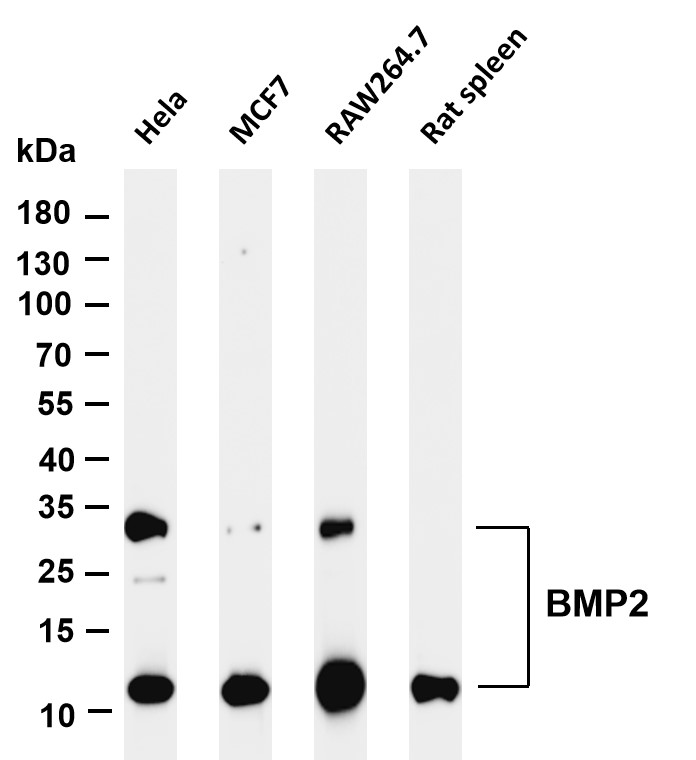BMP2 (PT0362R) PT® Rabbit mAb
- Catalog No.:YM8215
- Applications:WB;IHC;IF;IP;ELISA
- Reactivity:Human; Mouse; Rat;
- Target:
- BMP-2
- Fields:
- >>Cytokine-cytokine receptor interaction;>>TGF-beta signaling pathway;>>Hippo signaling pathway;>>Pathways in cancer;>>Basal cell carcinoma
- Gene Name:
- BMP2
- Protein Name:
- Bone morphogenetic protein 2
- Human Gene Id:
- 650
- Human Swiss Prot No:
- P12643
- Mouse Gene Id:
- 12156
- Mouse Swiss Prot No:
- P21274
- Rat Gene Id:
- 29373
- Rat Swiss Prot No:
- P49001
- Specificity:
- endogenous
- Formulation:
- PBS, 50% glycerol, 0.05% Proclin 300, 0.05%BSA
- Source:
- Monoclonal, rabbit, IgG, Kappa
- Dilution:
- IHC 1:200-1:1000;WB 1:1000-1:5000;IF 1:200-1:1000;ELISA 1:5000-1:20000;IP 1:50-1:200;
- Purification:
- Protein A
- Storage Stability:
- -15°C to -25°C/1 year(Do not lower than -25°C)
- Other Name:
- BMP2;BMP2A;Bone morphogenetic protein 2;BMP-2;Bone morphogenetic protein 2A;BMP-2A
- Molecular Weight(Da):
- 45kD,13kD
- Observed Band(KD):
- 30kD,13kD
- Background:
- This gene encodes a secreted ligand of the TGF-beta (transforming growth factor-beta) superfamily of proteins. Ligands of this family bind various TGF-beta receptors leading to recruitment and activation of SMAD family transcription factors that regulate gene expression. The encoded preproprotein is proteolytically processed to generate each subunit of the disulfide-linked homodimer, which plays a role in bone and cartilage development. Duplication of a regulatory region downstream of this gene causes a form of brachydactyly characterized by a malformed index finger and second toe in human patients. [provided by RefSeq, Jul 2016],
- Function:
- function:Induces cartilage and bone formation.,online information:Bone morphogenetic protein 2 entry,similarity:Belongs to the TGF-beta family.,subunit:Homodimer; disulfide-linked. Interacts with GREM2 (By similarity) and SOSTDC1.,tissue specificity:Particularly abundant in lung, spleen and colon and in low but significant levels in heart, brain, placenta, liver, skeletal muscle, kidney, pancreas, prostate, ovary and small intestine.,
- Subcellular Location:
- Secreted
- Expression:
- Particularly abundant in lung, spleen and colon and in low but significant levels in heart, brain, placenta, liver, skeletal muscle, kidney, pancreas, prostate, ovary and small intestine.
- June 19-2018
- WESTERN IMMUNOBLOTTING PROTOCOL
- June 19-2018
- IMMUNOHISTOCHEMISTRY-PARAFFIN PROTOCOL
- June 19-2018
- IMMUNOFLUORESCENCE PROTOCOL
- September 08-2020
- FLOW-CYTOMEYRT-PROTOCOL
- May 20-2022
- Cell-Based ELISA│解您多样本WB检测之困扰
- July 13-2018
- CELL-BASED-ELISA-PROTOCOL-FOR-ACETYL-PROTEIN
- July 13-2018
- CELL-BASED-ELISA-PROTOCOL-FOR-PHOSPHO-PROTEIN
- July 13-2018
- Antibody-FAQs
- Products Images

- Various whole cell lysates were separated by 4-20% SDS-PAGE, and the membrane was blotted with anti-BMP2 (PT0362R) antibody. The HRP-conjugated Goat anti-Rabbit IgG(H + L) antibody was used to detect the antibody. Lane 1: Hela Lane 2: MCF7 Lane 3: RAW264.7 Lane 4: Rat spleen Predicted band size: 45,13kDa Observed band size: 30,13kDa



